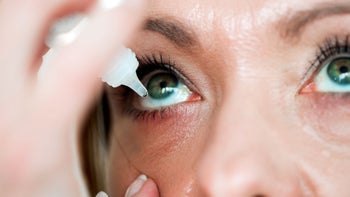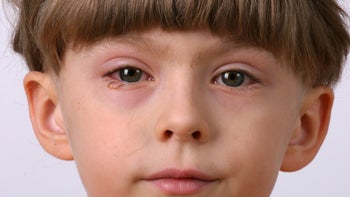
7 Ways to Stop Your Eyes From Watering
Key takeaways:
You can help stop your eyes from watering by taking over-the-counter lubricating eye drops and allergy medications and protecting your eyes from wind and smoke.
You can also apply a warm compress, use a humidifier if indoor air is dry, and give your eyes a break from digital screens to relieve watery eyes.
See an eye doctor if home treatments don’t work or if you have persistent redness, vision change, or feel a lump near your tear duct.

Having eyes that won’t stop watering can be frustrating. This condition — known as epiphora — can happen for many reasons.
Fortunately, some home treatments can help stop your eyes from watering. Applying lubricating eye drops, taking oral antihistamines, and avoiding environmental irritants are a few examples. However, in some cases, a healthcare professional can help determine why your eyes keep watering and find the best solution for relief.
How to stop your eyes from watering
There are several convenient ways to stop your eyes from watering. Here are seven tips.
Search and compare options
1. Use lubricating eye drops
It may sound strange to use lubricating eye drops if your eyes are already watering and you’re trying to stop it. But watery, irritated eyes can happen because of dry eyes. When your eyes are dry, this sends a signal for them to produce more tears, called reflex tears. But reflex tears aren’t enough to lubricate your eyes.
Over-the-counter (OTC) eye drops, often called artificial tears, add lubrication and moisture to the eyes. In doing so, they can stop the cycle of eye dryness and watering.
You can find artificial tears as liquids, gels, or ointments without a prescription. For people who use artificial tears several times per day or are sensitive to preservatives, preservative-free eye drops may be the best option.
Make sure to avoid any eye drops that say “get the red out.” If OTC lubricating eye drops are not relieving your dry eyes after a few days, see your primary care provider so they can get to the root of the problem.
2. Consider allergy medications
Watery eyes can happen from an allergic reaction to environmental triggers, like pollen or dust. When you are exposed to an allergen, your body releases histamine, a naturally occurring chemical. Histamine causes an allergic reaction.
This allergic reaction is sometimes called allergic rhinitis (seasonal allergies or hay fever). Besides watery eyes, allergic rhinitis symptoms include an itchy, runny, congested nose. You may also have a sore throat and headaches.
Read more like this
Explore these related articles, suggested for readers like you.
You can use oral OTC antihistamines like fexofenadine (Allegra) or levocetirizine (Xyzal Allergy) to get relief from allergic rhinitis. These oral antihistamines can block the allergic reaction and potentially stop your eyes from watering. Other OTC medications that can relieve the symptoms of allergic rhinitis are decongestants and steroid nasal sprays like fluticasone propionate (Flonase).
In some cases, another condition — allergic conjunctivitis — can cause watery eyes. For mild allergic conjunctivitis, you can use OTC eye drops with antihistamines, such as ketotifen (Zaditor) or olopatadine (Pataday).
If OTC eye drops don’t help your allergies or if your symptoms are severe, you may need a prescription allergy eye drop. In this case, you’ll need to see a healthcare professional.
3. Place a cool or warm compress over your eyes
Your eyes may be watery, red, swollen, and itchy if you have viral conjunctivitis (pink eye), a common eye infection. There’s no treatment for viral pink eye, and it generally goes away on its own in 2 to 3 weeks. But placing a cool, damp washcloth on closed eyes may help lessen the discomfort.
A cool compress may also help decrease any eyelid swelling or inflammation. Remember to use a new, clean washcloth each time to avoid spreading the infection.
For dry eyes, though, try a warm compress. A warm compress helps your eyelid glands release oils that improve lubrication in your tears. You can place a warm compress over your closed eyes for a few minutes or as often as is comfortable.
Here’s how to make a warm compress:
Add about 1 cup of dry rice to a sock.
Place the sock in the microwave for 10 to 15 seconds.
Then close your eyes and hold the warm compression in place for 10 minutes.
You can lightly massage your eyelids to help the glands produce more oil. Warm compresses are also helpful in treating blepharitis (inflammation of the eyelid), which can contribute to watery eyes when caused by dry eyes.
4. Add moisture with a humidifier
Dry indoor air can lead to dry eyes, which in turn can result in watery eyes. Adding moisture to the air with a humidifier may help prevent this.
A small study suggests that using a desktop humidifier while working on a computer may slightly lessen dry eye symptoms. The researchers noted that, with the humidifier, tears took longer to dry. But the humidifier didn’t affect the oil layer in the eyes. Some study participants said their eyes felt more comfortable after using the humidifier compared to those who didn't.
If you don't have a humidifier, put a pan or bowl of water around heat sources like radiators, vents, or fireplaces. This helps increase the humidity level in the surrounding air.
5. Reduce digital eye strain
Staring at a computer screen for a long time, especially without blinking enough, can make your eyes dry and watery. Your vision may also be blurry, and your eyes may feel tired and uncomfortable. These are symptoms of digital eye strain.
Here are a few ways to reduce digital eye strain and help stop watery eyes:
Blink frequently to keep your eyes moist.
Every 20 minutes, look at something at least 20 feet away for at least 20 seconds to give your eyes a break. This is known as the 20-20-20 rule.
Increase the contrast of your digital screen.
Set your screen’s brightness to match the level of light around you.
Use a matte screen filter to reduce glare, which can also contribute to eye discomfort.
Position your screen below eye level and 25 inches away (about arm’s length).
6. Give your eyes a break from contact lenses
Wearing contact lenses for extended periods often leads to dry eyes, which can cause them to water. If you also spend a lot of time looking at digital screens, like computers or phones, it can make this problem even worse.
To relieve dry, watery eyes from contact lenses, try the following:
Take a break from your contact lenses and wear glasses instead on some days.
Remove your contact lenses at bedtime, even if they’re meant for extended use.
Clean your contact lenses as instructed.
See your eye doctor if you notice persistent symptoms like:
Redness
Blurriness
Excessive tearing
Sensitivity to light
Pain in your eyes
7. Protect your eyes
Wind, smoke, and a very dry climate can trigger dry eye issues, leading to irritated, watery eyes.
When you’re outside on windy days, wear wrap-around glasses to protect your eyes from the wind. When inside, be aware of fans and air vents blowing directly on your face, as the airflow can dry out your eyes.
Cigarette and secondhand smoke contain particles that can irritate the eyes and cause dryness. It’s best to avoid places with smoke to prevent watery eyes.
What causes watery eyes?
While tears keep the eyes moist and healthy, watery eyes can be caused by irritating things like:
Foreign objects in the eye
Environmental irritants
Prolonged wear of contact lenses
Watery eyes can also be a symptom of underlying issues and conditions, including:
Dry eyes
Allergies
Infection (conjunctivitis or a sinus infection)
Blocked tear ducts
Eyelid issues, like ectropion or entropion
Corneal scratches
Blepharitis
When should you see a healthcare professional for watery eyes?
If you have watery eyes and notice certain concerning signs, it’s important to see a healthcare professional immediately. These signs include:
Repeated episodes of red, tearing eyes with no apparent trigger
A hard lump in or near the tear duct area
Changes in your vision
Feeling like something is stuck in your eye
These symptoms, especially when combined with watery eyes, could indicate a serious problem that needs medical attention.
If your symptoms don’t go away or change unexpectedly even after trying home treatments, talk to your care team about other options.
Even if you don’t have any concerning signs, it’s a good idea to schedule an appointment with your eye doctor to discuss your watery eyes. They can assess your condition and look for an underlying cause that may need treatment.
For example, if watering eyes are due to a blocked tear duct, your ophthalmologist can use special tools to open the blockage. In some cases, surgery may be needed.
The bottom line
Various issues or conditions can cause watery eyes. Convenient home treatments like OTC lubricating eye drops, oral antihistamines, or nasal steroid sprays may help stop your eyes from watering. Additionally, protecting your eyes from environmental irritants and taking breaks from contact lenses may help prevent watery eyes.
If home treatments don’t work, schedule an appointment with your eye doctor. See your healthcare provider if you have persistent redness with watery eyes, notice a hard lump near your tear duct, have vision changes, or develop eye pain.
Why trust our experts?



References
American Optometric Association. (n.d.). Computer vision syndrome.
American Optometric Association. (n.d.). Conjunctivitis (pink eye).
Boyd, K. (2015). Blocked tear duct treatment. American Academy of Ophthalmology.
Boyd, K. (2018). Remedies to reduce dry eye symptoms. American Academy of Ophthalmology.
Boyd, K. (2023). Computers, digital devices and eye strain. American Academy of Ophthalmology.
Boyd, K. (2023). What is dry eye? Symptoms, causes, and treatment. American Academy of Ophthalmology.
Brady, C. J. (2023). Tearing. Merck Manual Professional Version.
Chang, A. Y. et al. (2023). Biochemistry, tear film. StatPearls.
Fried, M. P. (2023). Rhinitis. Merck Manual Consumer Version.
Golden, M. I. (2023). Dry eye syndrome. StatPearls.
Markoulli, M., et al. (2017). Contact lens wear and dry eyes: Challenges and solutions. Clinical Optometry.
Wang, M. T. M., et al. (2017). Randomized trial of desktop humidifier for dry eye relief in computer users. Optometry and Vision Science.





























